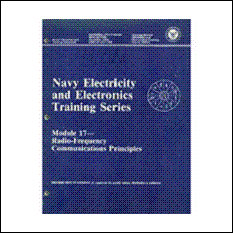The CRT
The CRT Graticule It is simply a calibrated scale (made of clear plastic) of amplitude versus time that is placed on the face.
A GRATICULE was used in the previous tutorial.
The graticule can be used to determine the voltage of waveforms because the DEFLECTION SENSITIVITY of the CRT is uniform throughout the vertical plane of the screen. Deflection sensitivity states the number of inches, centimeters, or millimeters a beam will be deflected for each volt of potential difference applied to the deflection plates. It is directly proportional to the physical length of the deflection plates and their distance from the screen and inversely proportional to the distance between the plates and to the second-anode voltage. Deflection sensitivity is a constant that is dependent on the construction of the tube.
Deflection sensitivity for the CRT might typically be 0.2 millimeters per volt. This means the spot on the screen will be deflected 0.2 millimeters (about 0.008 inch) when a difference of 1 volt exists between the plates. Sometimes the reciprocal of deflection sensitivity (called DEFLECTION FACTOR) is given. The deflection factor for the example given would be 125 volts per inch (1/0.008).
In the above example, 125 volts applied between one set of plates would deflect the beam 1 inch on the screen. This means that the deflection caused by small signals would likely not be observed. For this reason, the deflection plates are connected to amplifiers that magnify the signals applied to the vertical input of the scope.
Assume, for example, that a peak-to-peak value of a known voltage
applied to the oscilloscope indicates that each inch marking on the
graticule is equal to 60 volts. Each of the 10 subdivisions will,
therefore, equal a value of 6 volts. Most oscilloscopes have ATTENUATOR
controls to decrease or GAIN controls to increase the strength of a
signal before it is placed on the deflection plates. Attenuator and gain
settings must not be disturbed after the calibration has been made. For
maximum accuracy, you should recalibrate the graticule each time a
voltage is to be measured.
CRT DESIGNATIONS
Cathode-ray tubes are identified by a tube number, such as 2AP1, 2BP4, or 5AP1A. The first number identifies the diameter of the tube face. Typical diameters are 2 inches, 5 inches, and 7 inches. The first letter designates the order in which a tube of a given diameter was registered. The letter-digit combination indicates the type of phosphor (glowing material) used on the inside of the screen.
Phosphor P1, which is used in most oscilloscopes, produces a
green light at medium PERSISTENCE. Persistence refers to the length of
time the phosphor glows after the electron beam is removed. P4 provides a
white light and has a short persistence. If a letter appears at the
end, it signifies the number of the modification after the original
design.
OSCILLOSCOPE CONTROL COMPONENTS
Although the CRT is a highly versatile device, it cannot operate without control circuits. The type of control circuits required depends on the purpose of the equipment in which the CRT is used.
There are many different types of oscilloscopes. They vary from relatively simple test instruments to highly accurate laboratory models. Although oscilloscopes have different types of circuits, most can be divided into the basic sections shown in the figure below: (1) a CRT, (2) a group of control circuits that control the waveform fed to the CRT, (3) a power supply, (4) sweep circuitry, and (5) deflection circuitry.

Block diagram of an oscilloscope.
The figure below is a drawing of the front panel of a dual-trace, general-purpose oscilloscope. Oscilloscopes vary greatly in the number of controls and connectors. Usually, the more controls and connectors, the more versatile the instrument. Regardless of the number, all oscilloscopes have similar controls and connectors.
Once you learn the fundamental operation of these common controls, you can move with relative ease from one model of oscilloscope to another. Occasionally, controls that serve similar functions will be labeled differently from one model to another. However, you will find that most controls are logically grouped and that their names usually indicate their function.

Dual trace oscilloscope.
The oscilloscope shown above is called DUAL-TRACE because it can accept and display two vertical signal inputs at the same time—usually for comparison of the two signals or one signal and a reference signal. This scope can also accept just one input. In this case, it is used as a SINGLE-TRACE OSCILLOSCOPE. For the following discussion, we will consider this to be a single-trace oscilloscope. You are likely to use this one (model AN/USM-425) or one very similar to it. We will cover the front panel controls in the next tutorial.

















